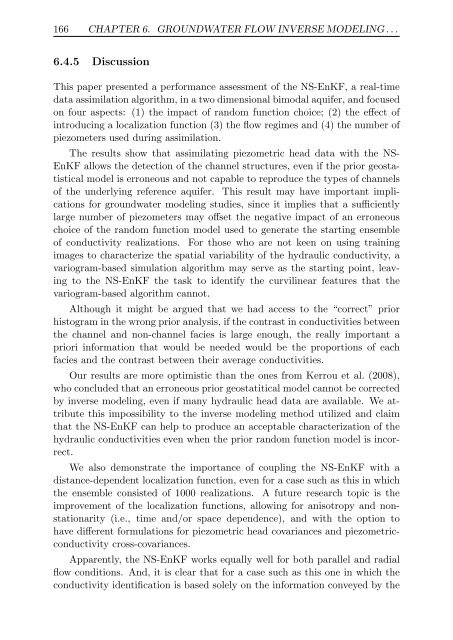Upscaling and Inverse Modeling of Groundwater Flow and Mass ...
Upscaling and Inverse Modeling of Groundwater Flow and Mass ...
Upscaling and Inverse Modeling of Groundwater Flow and Mass ...
Create successful ePaper yourself
Turn your PDF publications into a flip-book with our unique Google optimized e-Paper software.
166 CHAPTER 6. GROUNDWATER FLOW INVERSE MODELING . . .<br />
6.4.5 Discussion<br />
This paper presented a performance assessment <strong>of</strong> the NS-EnKF, a real-time<br />
data assimilation algorithm, in a two dimensional bimodal aquifer, <strong>and</strong> focused<br />
on four aspects: (1) the impact <strong>of</strong> r<strong>and</strong>om function choice; (2) the effect <strong>of</strong><br />
introducing a localization function (3) the flow regimes <strong>and</strong> (4) the number <strong>of</strong><br />
piezometers used during assimilation.<br />
The results show that assimilating piezometric head data with the NS-<br />
EnKF allows the detection <strong>of</strong> the channel structures, even if the prior geostatistical<br />
model is erroneous <strong>and</strong> not capable to reproduce the types <strong>of</strong> channels<br />
<strong>of</strong> the underlying reference aquifer. This result may have important implications<br />
for groundwater modeling studies, since it implies that a sufficiently<br />
large number <strong>of</strong> piezometers may <strong>of</strong>fset the negative impact <strong>of</strong> an erroneous<br />
choice <strong>of</strong> the r<strong>and</strong>om function model used to generate the starting ensemble<br />
<strong>of</strong> conductivity realizations. For those who are not keen on using training<br />
images to characterize the spatial variability <strong>of</strong> the hydraulic conductivity, a<br />
variogram-based simulation algorithm may serve as the starting point, leaving<br />
to the NS-EnKF the task to identify the curvilinear features that the<br />
variogram-based algorithm cannot.<br />
Although it might be argued that we had access to the “correct” prior<br />
histogram in the wrong prior analysis, if the contrast in conductivities between<br />
the channel <strong>and</strong> non-channel facies is large enough, the really important a<br />
priori information that would be needed would be the proportions <strong>of</strong> each<br />
facies <strong>and</strong> the contrast between their average conductivities.<br />
Our results are more optimistic than the ones from Kerrou et al. (2008),<br />
who concluded that an erroneous prior geostatitical model cannot be corrected<br />
by inverse modeling, even if many hydraulic head data are available. We attribute<br />
this impossibility to the inverse modeling method utilized <strong>and</strong> claim<br />
that the NS-EnKF can help to produce an acceptable characterization <strong>of</strong> the<br />
hydraulic conductivities even when the prior r<strong>and</strong>om function model is incorrect.<br />
We also demonstrate the importance <strong>of</strong> coupling the NS-EnKF with a<br />
distance-dependent localization function, even for a case such as this in which<br />
the ensemble consisted <strong>of</strong> 1000 realizations. A future research topic is the<br />
improvement <strong>of</strong> the localization functions, allowing for anisotropy <strong>and</strong> nonstationarity<br />
(i.e., time <strong>and</strong>/or space dependence), <strong>and</strong> with the option to<br />
have different formulations for piezometric head covariances <strong>and</strong> piezometricconductivity<br />
cross-covariances.<br />
Apparently, the NS-EnKF works equally well for both parallel <strong>and</strong> radial<br />
flow conditions. And, it is clear that for a case such as this one in which the<br />
conductivity identification is based solely on the information conveyed by the


